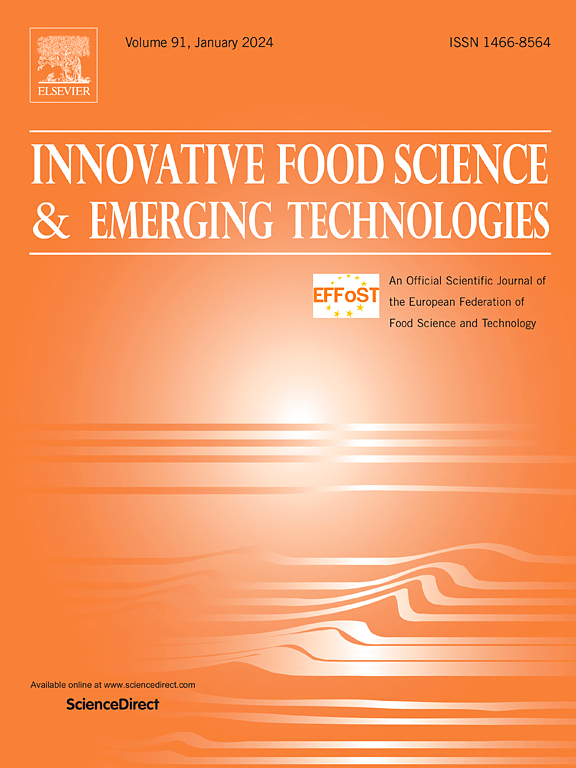Combined effects of pulsed electric field and soursop leaf extract treatment and modified atmosphere packaging on melanosis inhibition and shelf-life elongation of Pacific white shrimp during refrigerated storage
IF 6.3
1区 农林科学
Q1 FOOD SCIENCE & TECHNOLOGY
Innovative Food Science & Emerging Technologies
Pub Date : 2024-12-17
DOI:10.1016/j.ifset.2024.103903
引用次数: 0
Abstract
The efficacy of pulsed electric field (PEF) along with the treatment of 1 % soursop leaf extract (SLE) without and with the aid of vacuum impregnation (VI), followed by modified atmosphere packaging (MAP) on the quality and shelf-life of refrigerated Pacific white shrimp over 18 days of storage at 4 °C was evaluated. Melanosis and color alteration, microbial and chemical, textural and sensorial changes were monitored. The combinations of PEF, SLE, VI and MAP treatments could preserve the textural integrity and inhibited microbial growth more effectively than the control sample. Shrimp with combined hurdles namely PEF-SLE1 (1 %)-VI-MAP1 (60 % CO2, 30 % N2, 10 % Ar) and PEF-SLE1-MAP1 showed lower alterations in pH (7.68 and 7.87), total volatile base content (19.27 and 23.80 mg N/100 g), peroxide value (3.8 and 4.06 mg cumene hydroperoxide/kg) and thiobarbituric acid reactive substances (TBARS) (2.91 and 3.19 mg MDA/kg), respectively, after 18 days of refrigerated storage. Nonetheless, the control sample kept for the same period had the higher changes of pH (9.25), total volatile base content (35.19 mg N/100 g), peroxide value (6.23 mg cumene hydroperoxide/kg) and TBARS value (5.07 mg malonaldehyde/kg). The identification of 29 volatile organic compounds (VOCs) revealed that the control had the highest degree of spoilage. Additionally, the sensory evaluation confirmed that the treated samples, particularly PEF-SLE1-VI-MAP1, was generally considered ‘acceptable’ after 18 days of storage. Overall, the integration of PEF, 1 % SLE with VI and MAP1 demonstrated the potential in mitigating melanosis and lengthening the shelf-life of shrimp. These findings validate the use of alternative natural extract and non-thermal techniques to maintain the quality of refrigerated seafoods.
Industrial relevance
Pacific white shrimp are susceptible to melanosis and microbial spoilage, causing substantial economic loss for shrimp farmer and industry. The application of natural additives, particularly plant extracts such as soursop leaf extract, offers a promising means for shrimp quality maintenance. Pretreatment of the shrimp with PEF facilitates the creation of micro-pores in the shrimp shell, thereby enhancing the penetration of active compounds from the plant extract through vacuum impregnation. The use of selective modified atmosphere packaging retards melanosis, growth of certain spoilage bacteria, and lipid oxidation. This is attributed to the combined effects of different gases, where CO2 may hinder the metabolic activity of the dorminant aerobic bacteria, extending the lag phase and lowering the pH due to carbonic acid formation when CO2 reacts with the moisture on the shrimp surface. Nitrogen and argon are inert gases and help prevent lipid oxidation and displace oxygen, which plays a key role in melanosis. Therefore, this integrated hurdle approach can potentially be an effective method for quality preservation and shelf-life extension of shrimp and other crustaceans, ensuring both product safety and quality for consumers.
求助全文
约1分钟内获得全文
求助全文
来源期刊
CiteScore
12.00
自引率
6.10%
发文量
259
审稿时长
25 days
期刊介绍:
Innovative Food Science and Emerging Technologies (IFSET) aims to provide the highest quality original contributions and few, mainly upon invitation, reviews on and highly innovative developments in food science and emerging food process technologies. The significance of the results either for the science community or for industrial R&D groups must be specified. Papers submitted must be of highest scientific quality and only those advancing current scientific knowledge and understanding or with technical relevance will be considered.

 求助内容:
求助内容: 应助结果提醒方式:
应助结果提醒方式:


